I was recently able to acquire two fresh partial ostrich legs from a breeder. This was a perfect chance to study the external and internal anatomy of this giant bird’s legs and feet. I could take a really close look at things that I could neither see in a living ostrich in a zoo nor in a mounted taxidermy specimen. For me this was particularly interesting because I gould get firsthand data about anatomical details for sculptures and illustrations for which it’s very hard to find good references.
The feet of the ostrich are weird, even grotesque compared with normal bird feet. They are quite likely the most derived feet of any extant flightless bird. Functionally they are closer to the feet of an ungulate than to those of a typical avian. The first toe is enormous in size and has a wide and nearly hoof-like nail whereas the second toe is much shorter, flattened and has no more claw at all. Instead it has a very tough and robust skin with soft pads at the proximal bones. Those pads are made of rounded fat deposits which are embedded within the surrounding connective tissue. The second toe reminded me a lot on the soft-padded toes of camels. The dissection and removal of the skin from this toe without a lateral cut was just awful, and I am not willed to do this ever again.

Before you continue reading I have to apologize for not using that many references and super-correct descriptions for the underlying anatomy of the foot and leg. I really wanted to focus particularly on the scales, and the very large number of photos here made it already quite time-consuming to write the blog post. As there was also a lot of discussion about this topic, I also hoped to finish it today. If I find some more time, I´ll try to make an edited version with some more background information. I also realized when I wrote this that I had lesser usable photos than I thought, because the quality of some of the photos I took was not good enough.
What I found particularly interesting was the large variation of different scale types on different parts of the leg. Of course this is especially good to see in an ostrich, simply because it is such a huge bird. I think that even many people who are familiar with birds are not really that aware of the complex patterns and differences of the scales on bird legs. I write this all also not only to tell you something about the anatomy of modern birds but also as a help for paleoartists to provide some references which could be helpful for depictions and sculpted reconstructions of dinosaurs and prehistoric birds. Luckily we have several really good fossils and also some very nice track fossils which show us partial skin patterns of certain dinosaurs. I was quite surprised to see nearly the whole range of all known dinosaur scale variants on this single ostrich foot and lower leg, plus some more which I’ve never seen in a fossil.I thought it would be best to start at the base of the legs and go further down up to the toe tips.

There was an area of extremely thick skin at the ankle area. The scales were highly keratinized and formed some kind of knee pad to protect the underlying parts.
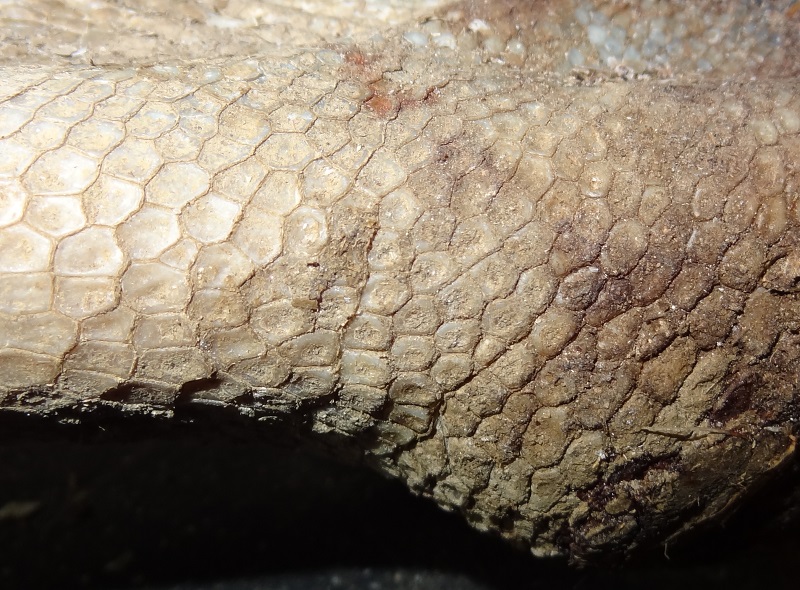
You can also see how a lot of dirt was pressed in-between the scales of the ankle area.

This is the ankle area in side view. You can see the „knee pad“ area and the highy wrinkled and much softer and thin skin behind it.

This photo shows the scales at about the midle of the leg. If you take a close look you can already see how the scales differ at the front side and back side.

Some more photos from the middle of the leg:


I found this scales especially interesting, as they have quite well pronounced bumps.

Those lower legs consists nearly only of bone and giant sinews wrapped in skin.

You see here the area where large irregular and somewhat thickened scales are forming into the pronounced scutes.

On this photo you can see the large scutes which are located in the area above the foot. At this little segment you can already see a whole lot of different sizes and shapes of scales.

The skin at the backside of the tarsometatarsus is very soft and loose and forms very big folds to allow enough flexibility.
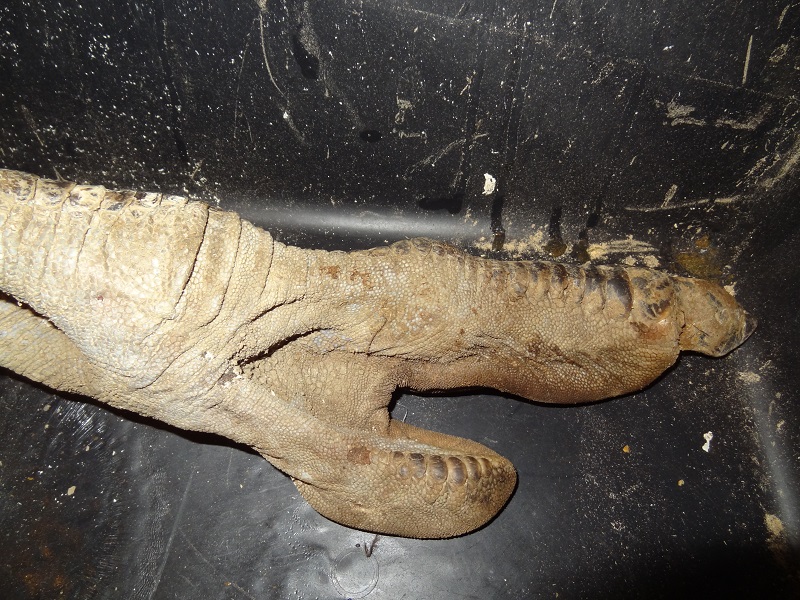
Here´s again another view of the whole foot.

The big scutes don´t form a line up to the toe tip but are interrupted by smaller scales…

…just to form again large scales over the big toe. You can again see an interruption of the scutes where they break into a double line of smaller scutes.

The largest scutes are at the proximal end of the toe and form big shields.
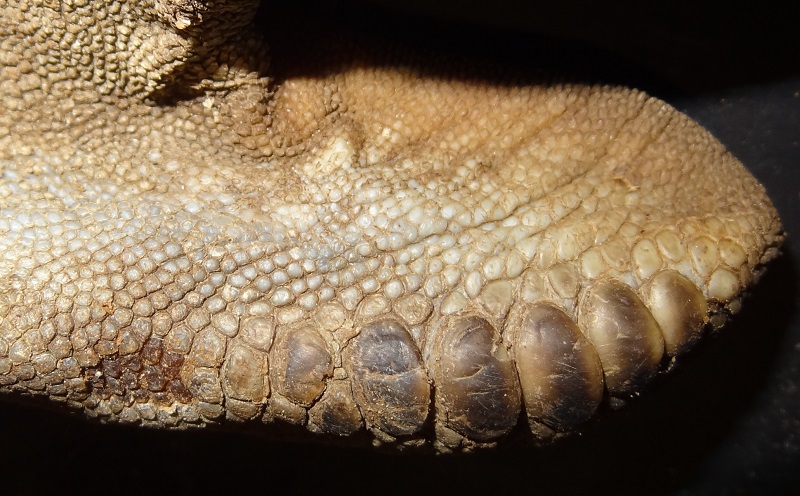
Now the smaller lateral too is really weird. You can see thick and polygonal scales with highly keratinized surfaces on the left which are similar to those at the ankle area. But also their transformation into the large scutes on the upper sides of the toe and rounded, smooth scales with large areas of skin in-between on the sides.

Another detail of the photo above.

Now let´s take a look at the bottom of the foot. The nail is very short, wide and blunt and feels nearly like a hoof.
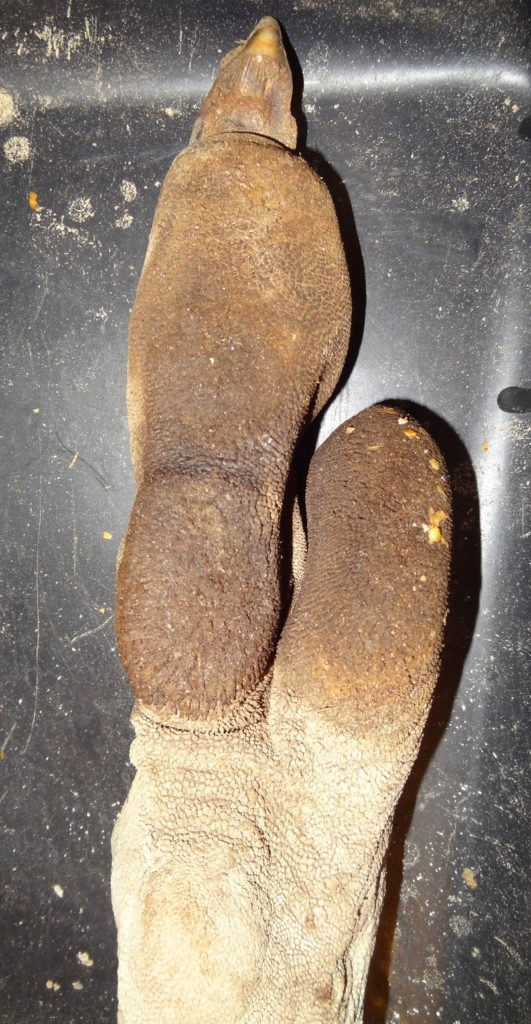
Most of the scales on the sole of the toes are very small and highly keratinized and form dense pads.

But what the heck is going on here? The scales at the centre of the foot form into bizarre upwards turned structures.
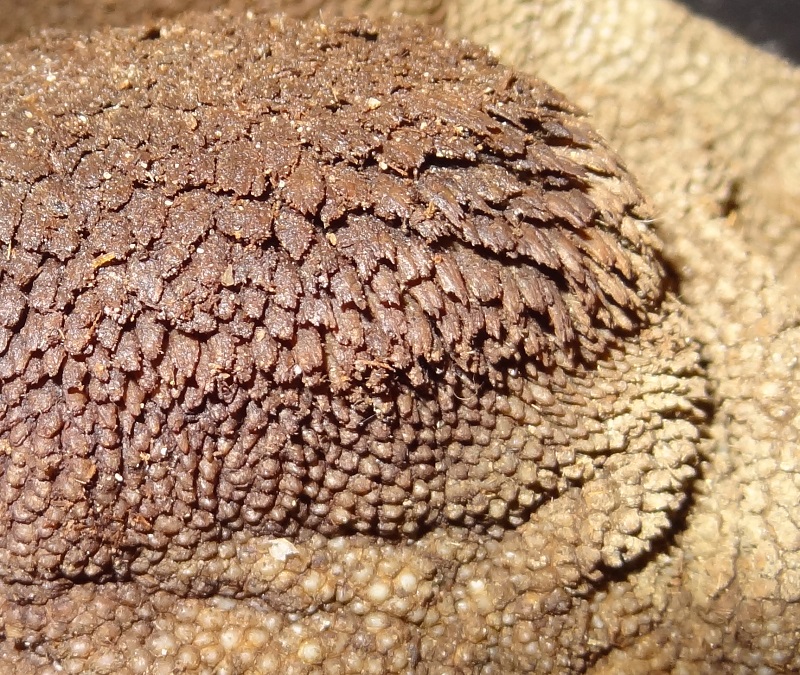
Now this looks really super-gnarly. Can you imagine how the feet of a large theropod or even sauropod could have had similar or even more extreme scale formations?

The area behind this spikey pads is again formed from very small, very irregular scales.
This really large number of very different and highly specialized scales is an important reminder that even fossilized patches of dinosaur skin show us still only a small fraction of their bodies. We also have to keep in mind that this ostrich leg is just an ostrich leg and should not be used as a universal reference. The sizes, patterns, shapes and functions of the scales on bird legs are much more diverse than many people think and we can be next to sure that there were also a lot of different scale types present in dinosaurs, even if they were usually not as elaborate and dragonesque as in some modern squamates. As this topic evoked a lot of interest in recent online discussions about dinosaur skin I decided to write some more blog posts dedicated to this, especially to feature some more non-standard scale patterns on bird legs.


I really appreciate this post. It does emphasise that avian scales are highly variable which is further exacarbated by them being homologous to feathers. Seeing these variable scales certainly brings home that dinosaurian integument integument must have taken on an endless variety and were undoubtedly developmentally plastic.